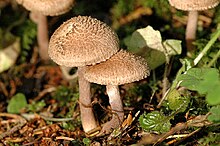Inocybaceae
| Inocybaceae | |
|---|---|

| |
| Inocybe lanuginosa | |
| Scientific classification | |
| Domain: | Eukaryota |
| Kingdom: | Fungi |
| Division: | Basidiomycota |
| Class: | Agaricomycetes |
| Order: | Agaricales |
| Family: | Inocybaceae Jülich (1981) |
| Type genus | |
| Inocybe (Fr.) Fr. (1863)
| |
| Genera | |
|
Auritella | |
The Inocybaceae are a
Taxonomy
The type genus of the Inocybaceae, Inocybe, was originally described by Fries in 1821, as a 'tribe' within a broad mushroom genus, Agaricus.[1] In 1863, Fries elevated Inocybe to generic rank.[1]
Inocybe, had traditionally been placed within the family
Inocybaceae has only become an independent family somewhat recently. The family is now split into 7 different clades, all recognized with generic rank: Auritella, Inocybe sensu stricto, Inosperma, Mallocybe, Nothocybe, Pseudosperma, and Tubariomyces[16]. It is estimated that Inocybe (the largest genus within Inocybaceae) contains ca. 1050 species; Pseudosperma with ca. 70 species; Mallocybe with more than 55 species; Inosperma containing 70+ known species; and Auritella, Nothocybe, and Tubariomyces containing an unknown number of species, but estimated to be in rather small numbers.[16]
In a 2019 molecular study, Matheny and colleagues used six gene phylogenetic analyses to determine relationships within the family. They recovered Nothocybe as sister to Inocybe, while members of Inocybe section Rimosae formed a lineage that diverged from the ancestor of the preceding two, and hence reclassified it as a genus Pseudosperma. Another branch gives rise to four lineages - the genus Auritella, what was Inocybe subgenus Mallocybe (now Mallocybe[17]), Tubariomyces, and Inosperma (previously Inocybe subgenus Inosperma).[18]
Distribution
The Inocybaceae are widespread in north temperate regions, but also found in the tropics and the Southern Hemisphere. Members of this family have also been encountered in Africa, Australia, the neotropics, New Zealand, the north temperate zone, the paleotropics, Southeast Asia, South America, and the south temperate zone.[19]
Ecology
Members of Inocybaceae are
See also
References
- ^ a b c d Matheny, P. Brandon (2009). "A phylogenetic classification of the Inocybaceae" (PDF). McIlvainea. 18 (1): 11–21 – via mycopedia.ch.
- ^ PMID 20170738.
- PMID 18282272.
- ISBN 978-0-85199-827-5.
- ISBN 978-3-87429-254-2.
- ISBN 978-0-85199-377-5.
- ^ Jülich W. (1982). Higher taxa of Basidiomycetes. Bibliotheca Mycologia 85. Cramer, Vaduz. 485 pp.
- PMID 12118409.
- PMID 12099793.
- PMID 15737578.
- ^ ISBN 978-0-85199-826-8.
- ^ Vizzini A (2008). "Novitates. Tubariaceae fam. nov". Rivista di Micologia. 51: 174.
- PMID 17486974.[permanent dead link]
- S2CID 53694501.
- S2CID 84495351.
- ^ ISSN 1589-1623.
- S2CID 256277591.
- ^ S2CID 209407151.
- S2CID 85164367.
